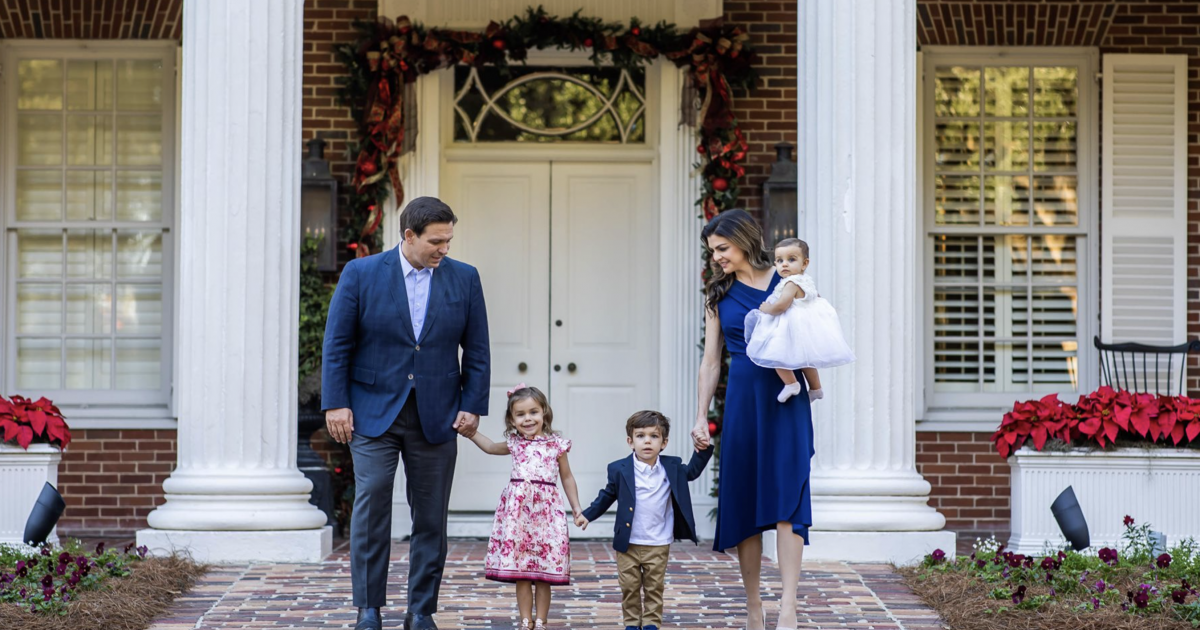Casey DeSantis' Inspiring Breast Cancer Battle
- Florida's First Lady, Casey DeSantis, 41, was celebrated by Republican women in Florida and given an award for inspiring others over the weekend, just three months after beating breast cancer.
- Gov. Ron DeSantis of Florida announced in October 2021 that his wife had been diagnosed with breast cancer. In March, it was announced that Casey was officially cancer-free!
- There are many treatment options for people with breast cancer, but treatment depends greatly on the specifics of each case. However, the stage and type of Casey’s disease wasn’t ever made public.
"We are mammas on a mission to protect our children. In Florida, the buck stops with the parents," DeSantis said Saturday at the Women of Distinction Awards Program and Gala, which was held at St. Cecilia's Catholic Church in Fort Myers, Fla., according to Fox News.
Read More
Casey DeSantis' Breast Cancer Battle
Gov. Ron DeSantis of Florida announced in October 2021 that his wife had been diagnosed with breast cancer. He and Casey DeSantis both spoke about her diagnosis during the following months, and both remained hopeful she would one day be deemed cancer-free.In December of last year, Casey spoke publicly for the first time about her diagnosis, revealing some new details about the timeline of her diagnosis. The stage and type of her breast cancer remains unknown to the public.
She told a crowd gathered at the Moffitt Cancer Center in Tampa, Fla., that she didn’t experience any symptoms initially, but a vague sense of uneasiness drove her to schedule a visit with her OB-GYN.
Her doctor didn’t see any cause for concern, but Casey couldn’t shake her suspicion. One month later, she called again to request a mammogram. This time, her concerns were confirmed she was diagnosed with breast cancer.
Casey DeSantis began chemotherapy treatment shortly after, and in January, the governor and first lady announced that she had finished her breast cancer treatment. Gov. DeSantis later announced that his wife had surgery for her breast cancer, however, it's unclear when she had the surgery or what type of procedure she had.
Should I Have a Lumpectomy or Mastectomy?
Common breast cancer surgeries include either a ​​lumpectomy or a mastectomy.
A ​​lumpectomy is surgery to remove cancer or other abnormal tissue from the breast, while a mastectomy is breast cancer surgery that removes the entire breast. Sometimes, women will undergo a double mastectomy, which is when both breasts are removed. Women can then opt to go through additional reconstruction surgery.
In March, Gov. DeSantis announced that Casey was officially cancer-free!
Excited to share this update about First Lady @FLCaseyDeSantis' health: pic.twitter.com/HsMjWwPHIv
Ron DeSantis (@GovRonDeSantis) March 3, 2022
"After going through both treatment and surgery for breast cancer, she is now considered cancer-free," the governor said in a video shared to Twitter.
"For all the women out there who are going through breast cancer right now: you can overcome this," he continued. "I know it's very difficult, but my wife is proof positive. If you wound back six or seven months, this is exactly the type of news that we had hoped for."
"She still has more to do, but I'm confident she's going to make a full recovery."
Casey DeSantis also shared her thoughts about being cancer-free: “There are no words to express how truly blessed, grateful and humbled I am to hear the words cancer free,” she posted to Twitter. “To those who are in the fight, know there is hope. Have faith and stay strong.”
There are no words to express how truly blessed, grateful and humbled I am to hear the words cancer free. To those who are in the fight, know there is hope. Have faith and stay strong. https://t.co/lAwy7w0Qb9
Casey DeSantis (@FLCaseyDeSantis) March 3, 2022
Understanding Breast Cancer
Breast cancer is a common cancer that's been the subject of much research. Many women (like Casey DeSantis) develop breast cancer every year, but men can develop this cancer, too though it’s more rare, in part, due to the simple fact that they have less breast tissue.
There are many treatment options for people with this disease, but treatment depends greatly on the specifics of each case. (As previously mentioned, the stage and type of Casey’s disease wasn’t ever made public.)
Identifying these specifics means looking into whether the cancerous cells have certain receptors. These receptors the estrogen receptor, the progesterone receptor and the HER2 receptor can help identify the unique features of the cancer and help personalize treatment.
The Unique Features of Breast Cancer: Deciding the Right Course of Treatment
"These receptors I like to imagine them like little hands on the outside of the cell they can grab hold of what we call ligands, and these ligands are essentially the hormones that may be circulating in the bloodstream that can then be pulled into this cancer cell and used as a fertilizer, as growth support for the cells," Dr. Elizabeth Comen, a medical oncologist at Memorial Sloan Kettering Cancer Center, previously told SurvivorNet.
One example of a type of ligand that can stimulate a cancer cell is the hormone estrogen, hence why an estrogen receptor-positive breast cancer will grow when stimulated by estrogen. For these cases, your doctor may offer treatment that specifically targets the estrogen receptor. But for HER2-positive breast cancers, therapies that uniquely target the HER2 receptor may be the most beneficial.
"The good news is there are so many different treatments and options available, and doctors really are attuned to trying to understand patients better, to figure out what are their individual needs," Dr. Comen said.
Learn more about SurvivorNet's rigorous medical review process.


